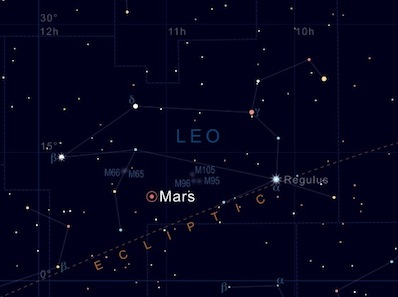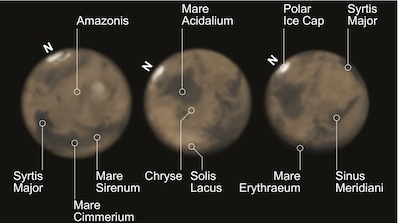


|

|
 |
|
Catch Mars at its best! MARK ARMSTRONG ASTRONOMY NOW Posted: 02 March 2012 Mars comes to opposition on 3 March, ending a seemingly never-ending wait for Mars aficionados for the red planet to be at its best. It’s been a long old haul since last summer when Mars reappeared in the morning sky following last February’s solar conjunction and a whopping 763 days since its last opposition in late January 2010. Now the wait is over and it’s time to enjoy Mars for an all too brief interlude.  Mars is moving retrograde through Leo during March and approaches to within six degrees of Regulus (alpha Leonis, mag. +1.3) by the end of March. By this time Mars will have faded to mag. -0.7 but still be a healthy 12.6 arcseconds across. Make the most of the clear nights in March to observe this mysterious and alluring planet. AN graphic by Greg Smye-Rumsby. Mars can be a very frustrating planet due to the aforementioned wait between oppositions and the significant fact that its pronounced eccentric orbit causes a huge difference in its apparent diameter at its best and worst oppositions. Unfortunately 2012 is an aphelic opposition (furthest from the Sun) and at best it will attain 13.9 arcseconds in size; at a perihelic opposition it can be as large as 25.1 arcseconds. At least this year it will be at a pretty good altitude due to its favourable northern declination (+10° 17.5’), climbing away from all the turbulence lower down that can very often hamper good seeing. Mars culminates at around 44 degrees from Edinburgh and almost 49 degrees from London on opposition night. Mars’ brightness at opposition varies widely too; at its closest, as in August 2003, it can be a mighty beacon at mag. -2.7 but although at a comparatively modest -1.2 this time around, Mars will outshine everything else outside of the Moon, Venus, Jupiter and Sirius. Its brightness and unmistakeable ruddy hue will easily betray its presence among the stars of Leo, with perhaps only orange Arcturus in Boötes, the brightest star in the Northern Hemisphere and 46 degrees away to the east, a possible source of misidentification.  Open larger image. This is the 'classic' view of Mars presented to us in the UK at 2am on 4 March. Prominent on the central meridian are the Syrtis Major and Hellas. Graphic made using Guide 8. On 3 March, Mars is 20 degrees up by 7.30pm and yields a very healthy nine-hour observing window, plenty of time to seek that fortuitous gap in the clouds or to really indulge oneself if the night is largely clear. Those with the stamina or early risers will have to curtail observing around 5am. Mars can be observed with a small telescope; an 80-mm aperture will show the bright north polar cap and the major dark surface markings such as the Syrtis Major. But to really study the planet visually then a 100-mm refractor or a 150-mm-200-mm reflector (the later in the case of a SCT) realistically is the minimum requirement. Many seasoned observers will not be happy with anything less than a 300-mm for this aphelic opposition. Try to aim for a magnification of x35 per inch (25mm) of aperture, with x150 the goal. If the seeing permits then ramp up the magnification as far as possible. Coloured filters are very useful to enhance the dark surface features, with orange/red Wratten 23A and 25 handy in this respect. Blue filters such as W80A and W38A are good for picking out clouds and haze in the Martian atmosphere. The north polar cap is well on show, appearing as a brilliant white spot in even small telescopes.  Mars as seen on the nights of 3 March (midnight), 17 and 24 March (both when Mars is rising). AN graphic by Greg Smye-Rumsby, based on data from Peter Grego. Any small telescope will show the planet’s darker markings, especially with the aid of the appropriate colour filter. Luckily for us in the UK, Mars’ ‘classic’ view, that with the dark ‘V’ shaped Syrtis Major and bordering bright Hellas region to south, appears on the following limb around 10pm and rotates to the Martian central meridian by 2am on 4 March. Observing Mars on successive nights at the same time sees these features gradually move back towards the following limb, giving the impression that Mars is ‘retro-revolving’ or rotating from east to west. This illusion is caused by the red planet’s slightly longer rotation period of 24 hours 39 minutes and 35 seconds than Earth’s 24 hours. The outcome of all this will mean the Syrtis Major will not be observable from about mid-March until around the 25th when it reappears right at the preceding limb as soon Mars is observable in the early evening. Then in the last week of March it will rotate more favourably into view. For more information on what Martian features are observable and when, be sure to pick up the March issue of Astronomy Now, which includes special articles on Mars in the Night Sky section. Planetary imagers will be in seventh heaven if we have clear skies around opposition. Increasing your ‘scopes focal length to f/30 to f/50 will give the necessary image scale and Mars’ slow rotation will allow ample time to secure many frames before any blurring. Please send any images or sketches to Astronomy Now picture gallery at gallery2012@astronomynow.com. |
|
|
|
|